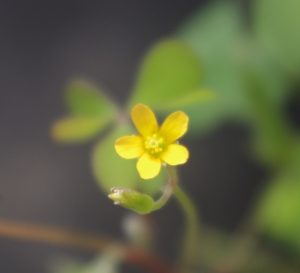Florida residents seeking a dose of luck this St. Patrick’s Day likely won’t find it among the weeds in their backyards.
Although oxalis stricta, a woodsorrel found throughout the state year-round, closely resembles the shamrock, a colloquial name for clover, the two plants are not biologically related, according to University of Florida Institute of Food and Agricultural Sciences (UF/IFAS) researchers.
In fact, oxalis is sometimes referred to as “false shamrock.”

Matthew Lollar, an agent for UF/IFAS Extension Santa Rosa County, has studied oxalis for years, but he’s never come across a four-leaf version of the plant, an anomalous clover feature said to bring good fortune to those who discover it.
Often, oxalis can prove a bit of a pest.
“It’s a native plant, but it’s usually considered a weed in yards and landscapes,” Lollar said.
Oxalis stricta is a low-growing, clumping plant, featuring green, heart-shaped leaflets. In the spring, it develops five-petaled, yellow flowers from three stalks emerging from the main stalk. Okra-shaped pods explosively discharge teardrop-shaped seeds when plants are disturbed.
“When a pod dries, anything it touches or even a strong enough wind will trigger it to open up, and seeds are scattered,” Lollar said.
A single plant is capable of producing up to 5,000 seeds each year. When those seeds germinate, they can produce offspring in undesirable locations.
“It might be unwanted in landscapes, but it can be a big issue in container nurseries,” said Chris Marble, a UF/IFAS associate professor of ornamental and landscape weed management at the Mid-Florida Research and Education Center.
In addition to spreading by seed, oxalis can spread through its underground rhizomes, or root systems. Removing plants by hand is difficult because doing so requires extracting the entire rhizome, a hydra of bulbs that easily break off.
“It’s a perennial, so that’s why you have to go through multiple approaches to control it,” Lollar said.
He recommends combating unwanted oxalis by applying pre-emergent herbicides.
“That way, you’re limiting its germination from seed, and then, eventually, hopefully, getting rid of it,” he said.
If plants are already established, Lollar recommends applying post-emergent herbicides.
Lollar’s property isn’t free of oxalis, but he’s adopted a laissez faire approach to taming it.
“It pops up everywhere in my yard,” he said, adding that his pet ducks like to nibble on it.
ABOUT UF/IFAS
The mission of the University of Florida Institute of Food and Agricultural Sciences (UF/IFAS) is to develop knowledge relevant to agricultural, human and natural resources and to make that knowledge available to sustain and enhance the quality of human life. With more than a dozen research facilities, 67 county Extension offices, and award-winning students and faculty in the UF College of Agricultural and Life Sciences, UF/IFAS brings science-based solutions to the state’s agricultural and natural resources industries, and all Florida residents.
 0
0
